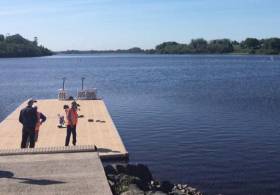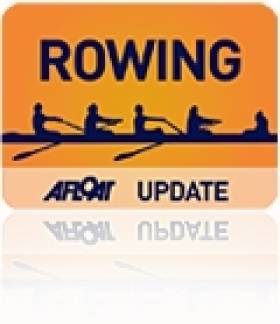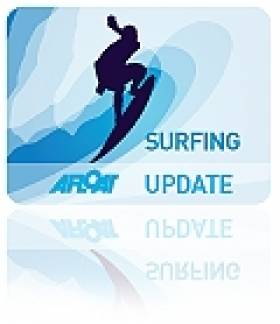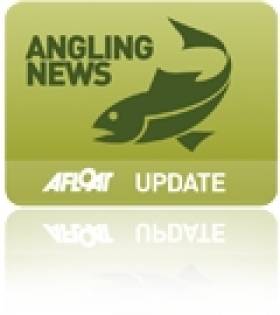Displaying items by tag: Leitrim
Tornado Capsizes Moored Motor-Cruisers In North Shannon Area
The damaging tornado which tore a narrow path through County Leitrim towards lunchtime yesterday (Sunday) may have very conspicuously swept roofs off buildings while flattening many trees. But as conditions settled back into a grey winter's afternoon and the visibility improved, boat people were astonished to find that some moored boats in the area - some quite substantial boats at that - had been overturned as they floated in their supposedly secure marina berths.
The boat numbers affected when all areas are accounted for are still being collated, but at the moment, the consolation is that the tornado path seems to have been quite narrow, though the high concentration of boats home-berthed in the area may yet result in a significant figure.
 Above and below) A cream-hulled Aquafibre 12-metre (circa 40ft) motorcruiser weighing approximately 10 tonnes is capsized on her mooring in Leitrim
Above and below) A cream-hulled Aquafibre 12-metre (circa 40ft) motorcruiser weighing approximately 10 tonnes is capsized on her mooring in Leitrim



The Civil Defence has put a boom in place to try and contain any diesel spillage.
 The Leitrim jetty is badly damaged after the tornado
The Leitrim jetty is badly damaged after the tornado
NEW ZEALAND EXPERIENCE OF MOORED FISHING BOAT CAPSIZED
As for motorboats on moorings or otherwise secured being capsized by rogue wind blasts, a number of cases have been documented. A notable one is that of a large ocean-going trawler on a mooring in the mountain-surrounded harbour of Wellington, New Zealand. The stability of such vessels with their often large amounts of top-hamper is much increased when they are underway, but being completely still out on moorings makes them sitting ducks, particularly when a freak mountainside-accelerated athwartships squall strikes seemingly out of nowhere.
This is what happened in Wellington. Observers saw the moored trawler disappearing into an impenetrable wall of spray and spume as the squall engulfed her, and when it cleared relatively quickly, the ship was upside-down and sinking rapidly.
The third phase of the Shannon Blueway has been opened by Michael Ring, Minister for Rural and Community Development, in the company of Waterways Ireland’s acting chief executive John McDonagh and Leitrim County Council Cathaoirleach Enda McGloin.
The project has created a new path along the shores of Lough Allen linking four tourism businesses to the lock at Blackrock and Drumshanbo town and increasing access for walkers, cyclists and horseriders.
This involved the upgrade of 1km of an existing pathway along the Lough Allen canal between Acres Cove Marina and Drumshanbo Lock at Blackrock, and the installation of a new controlled pedestrian crossing on the R208, the only road crossing on this section.
Car parking for 13 vehicles has also been created, with a new entrance to Drumshanbo Lock at Blackrock and the newly developed Blueway.
The new section of Blueway path runs north from this point along the shores of Lough Allen, and includes a pedestrian bridge across the Millrace River connecting the town with a range of existing amenities.
Funding for the project was obtained by a partnership of Waterways Ireland and Leitrim County Council under the Outdoor Recreational Infrastructure Scheme through the Department of Rural and Community Development.
A total of €340,000 of Outdoor Recreational Infrastructure funding has been match-funded with €86,000 by Waterways Ireland.
Minister Ring said: “I am delighted to launch Phase 3 of the Shannon Blueway here in Leitrim. This will build on the success of Phases 1 and 2 of this project which were supported by my Department and which have brought 100,000 new visitors to this rural area, creating opportunities for business growth, new businesses and jobs.
“Phase 3 links a further four existing business to the Blueway and will be instrumental in increasing the time and money people spend in this area. This has been a wonderful collaborative effort between my Department, Waterways Ireland and Leitrim County Council.”
John McDonagh added: “Blueways are an excellent way of linking the waterways and paths we manage with tourism businesses and recreation clubs providing opportunities for people to experience the outdoors, nature and adventure.”
Waterways Ireland says the Shannon Blueway has proved to be a catalyst for ongoing rural development, social inclusion and job creation, and had so far led to the establishment of eight water-based recreational businesses.
In 2018 alone, 100,000 visitors used the Blueway facilities at Acres Lake, which are utilised for numerous sporting and charitable events, as a community resource and public asset.
The opening in Leitrim comes in the same week as the launch of a new development guide and accreditation scheme for Blueway development on the island of Ireland.
This initiative sees a number of State agencies working in partnership on an all-island basis to see the development of Blueway sites in the Republic of Ireland and Northern Ireland over the coming years.
Big Entry for Lough Rynn Regatta
#Rowing: The second annual Lough Rynn Regatta will be held on the lake (Lough Rinn) near Mohill, Co. Leitrim on Saturday. The event is hosted by the Connacht Branch of Rowing Ireland.
The 2,000 metre course has eight lanes and is at top class facility. It was developed by Leitrim County Council. It is very accessible from the North, South and East of Ireland. It has a 1,000 metre area above the start where crews can warm up and a north-south orientation, which should minimise the effect of windy conditions.
This year’s entry is double that of last year: over 1700 competitors from 40 clubs will take to the water between 8am to 6pm in 107 races.
Free parking will be available at the Lough Rynn Hotel Golf Course Site. The carpark is 1.2km away from the enclosure and two shuttle buses will be provided throughout the day free of charge.
Members of the general public who wish to view this event are very welcome, entrance is free of charge.
Leitrim Angling Project Shares In Rural Waterways Stimulus Package
#Angling - Following the announcement of an €800,000 stimulus package for economic development on Ireland’s waterways, Inland Fisheries Ireland (IFI) has released details of Leitrim’s share to develop angling in Ballinamore.
An award of €100,000 from the Department of Arts, Heritage, Regional, Rural and Gaeltacht Affairs under the REDZ (Rural Economic Development Zone) Initiative will go to improving access to angling in Ballinamore with a view to developing tourism in the Lakelands region, as proposed by Leitrim County Council with support from IFI.
The project involves the development of angling infrastructure at Garadice and Kiltybarden Lakes, venues noted for match angling and currently annual hosts of the World Pairs Angling Championships. The €100,000 grant will upgrade the facilities at these locations to draw other national and international competitions to the area.
The angling facility will also be accessible to wheelchair users and will have a special area dedicated to youth angling.
In total the project will cost around €125,000, with the rest of the funding provided by IFI (€21,200) and Leitrim County Council (€3,800).
Frank Curran, chief executive of Leitrim County Council, said: “We are delighted with the approval of the funding for the Rural Economic Development Zone for Ballinamore and Carrigallen area which is focusing on the angling sector.
“Angling is an extremely important economic driver for this area made possible by the excellent fishing lakes in the locality along with a well-known, international reputation. Ballinamore/Carrigallen has been host to numerous angling competitions such as the World Pairs and the Dutch King of Clubs.
“Leitrim County Council looks forward to working with the local trade and Inland Fisheries Ireland in the delivery of this project in the coming months.”
IFI head of business development Suzanne Campion added: “Our fisheries resource is precious from a recreational and economic viewpoint. We are committed to ensuring that Ireland uses the resource to its best potential in a conservation focused manner and we are delighted to secure this funding for Leitrim.
“Anglers already enjoy the great fishing and beautiful scenery available at Ballinamore and this facility will make access to angling easier and allow the area to cater for several large and international angling competitions.
“Investment in angling development is crucial if we are to help attract visitors to rural areas. We know that angling visitors spend considerable time in an area when they identify with it as an angling destination. Anglers use several services and business in an area when visiting such as accommodation, restaurants, shops as well as boat hire and equipment rental.
“We look forward to working with our partners, Leitrim County Council and the community, in enhancing Ballinamore as a top angling destination.”
The Ballinamore project will form part of IFI’s National Strategy for Angling Development (NSAD), a comprehensive national framework for the development of Ireland’s angling resource.
The strategy aims to deliver a wide-ranging set of investments, innovations and promotions over the coming five years, to ensure that Ireland’s fish stocks and angling infrastructure are protected and enhanced for both their economic value and recreational benefit to the communities and visitors they serve across Ireland.
Shannon Blueway Launched with a Splash in Leitrim
#blueway – Minister Heather Humphreys TD, and actor & producer Carrie Crowley joined with over 300 walkers and paddlers to open the Shannon Blueway today in Drumshanbo, Co Leitrim.
As previously reported on Afloat.ie, the Shannon Blueway runs from Drumshanbo through Battlebridge and Leitrim Village to Carrick on Shannon. It includes 16.5km of water trail and over 10km of walking routes in three loops. The Shannon Blueway provides a range of recreational leisure activities such as walking, cycling, canoeing, fishing and cruising all linked by the waterways to local towns and villages.
Minister Heather Humphrey's stated "I am delighted to be launching this project here in Leitrim today. The Shannon Blueway has the potential to have a very positive impact on jobs and the regional economy. The Mayo Greenway, which is now in its 4th year of operation, has seen a jump in visitor numbers from 80,000 in 2011 to 300,000 in 2014. That means an extra €5 million was brought into the region. With the market for off road adventure tourism is growing here in Ireland and internationally, Leitrim is in a prime position to benefit from this trend.
The launch of the Blueway will allow local businesses can capitalise on an increase in demand for transport, equipment hire, accommodation and entertainment. I would like to commend Waterways Ireland for this initiative, which I have no doubt will have a very position impact on the region."
Carrie Crowley said "as a self-confessed blow-in to the area, the Shannon, the wonderful countryside and Leitrim people have provided me with a tranquil and inspirational place to work and home away from home .The only problem is, now our secret is out!"
The Shannon Blueway is the first of its kind in Ireland where a myriad of recreational activities have been developed and bundled together as a single or multiple visitor experience and tourism proposition. Waterways Ireland has, using the wonderful waterway assets, developed and built a canoe trail from Drumshanbo through Battlebridge and Leitrim Village to Carrick on Shannon. It has also developed a series of looped walks adjacent to the Lough Allen Canal with plans to expand those walks to Drumshanbo and Carrick on Shannon. At the same time Waterways Ireland is also developing a canoe trail from Leitrim Village along the 63km of the Shannon Erne Waterway with a walking and cycling trail also at an advanced stage of planning.
The Shannon Blueway is being delivered by Waterways Ireland in partnership of the National Trails Office, Canoeing Ireland, Leitrim County Council, Leitrim Tourism and Fáilte Ireland.

Minister Heather Humphreys TD, and WI Chief Executive Dawn Livingstone
Chief Executive Dawn Livingstone confirmed that partnership was the key to delivering the Shannon Blueway "Waterways Ireland has invested significantly in creating world beating facilities and services on the Shannon Navigation. Through our partnership with the National Trails Office, Canoeing Ireland, Leitrim Tourism and Leitrim County Council an outstanding multi-activity product has been built in the Shannon Blueway which is now being packaged by clubs and communities for their recreational activities and companies and organisations for domestic and international tourists. Partnership is key to delivering the future of the Shannon Blueway further into Leitrim, and indeed into Roscommon, Longford and Cavan."
The wider Shannon Blueway of which the Drumshanbo to Carrick on Shannon section is part, is at the heart of access to 100km of paddling area, 6 looped walks: 3 of which are on the canal towpath, two long distance walks and three heritage trails. The Shannon Blueway will ultimately provide access to 14 towns and services with each access point and town within an hours' paddling time.
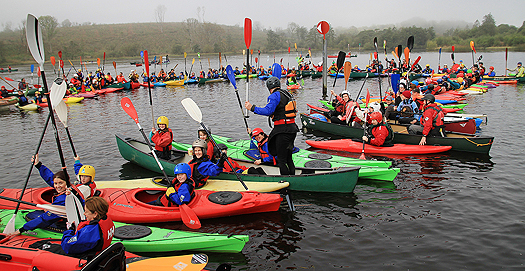
300 paddlers joined the ShannonBlueway launch
Waterways Ireland and Leitrim Co Co will shortly be examining the possibility of providing a connection from the jetties at Acres Lake to the canal towpaths and also to complete the walking/cycling connection to Carrick-on-Shannon, and up the Shannon-Erne Waterway.
€900,000 Rowing Facility Launched in County Leitrim
#rowing – The first phase of the International Rowing Facility in Lough Rinn, Co Leitrim, with an investment value of €900,000, has been completed and can now cater for rowing and canoeing enthusiasts from north Connaught, Leinster, Northern Ireland and further afield. The new facility was officially launched today by Michael Ring TD, Minister of State at the Department of Transport, Tourism and Sport with Special Responsibility for Tourism and Sport.
Speaking at the launch of the completion of the first phase Minister Ring TD, said "I'm delighted to be here to officially open the first phase of this project. This project is of considerable importance not only locally but nationally. Our aim was to create a world class facility which is a centre of excellence for the development of water sports in Ireland and we're very proud to have achieved that in the first phase of its development. The local community, visitors and indeed the athletes can now benefit from a unique shared space and enjoy all water activities including rowing, canoeing and fishing."
The facility has developed a 2,000 meter, eight lane facility which will be capable of hosting national and international events as well as acting as a training base for international teams in advance of major competitions.
The €900,000 funding for the project was provided by Leitrim Co. Co., Fáilte Ireland and the Department of Transport, Tourism and Sport. The facility will now enable Leitrim County Council in conjunction with Carrick on Shannon Rowing Club to host teams from Ireland and abroad.
Commenting on the importance of the new rowing facility to Leitrim, Frank Curran, CEO of Leitrim County Council said, "Today's launch really is a milestone for Leitrim, the development of this facility will not only raise the profile of Leitrim in a sporting sense but will also have a considerable impact on the local economy and tourism industry. By its very location, this new facility will be extremely accessible for rowing clubs and teams from Northern Ireland, Dublin and the UK."
The centre is a 162 hectares lake which is 3,000 meters in length and ideally suited for rowing and the development project has seen the creation of an eight-Lane Albano Rowing Course and Anchorage which is multi-functional and adjustable to meet rowing standards as specified by FISA (Fédération Internationale des Sociétés d'Aviron). It is also adjustable to meet requirements of International Canoe Federation Canoe Sprint Competition Rules. In addition a launch pontoon and slipway have been developed and an amenity block building has been refurbished to cater for visitors.
Rowers and spectators who visit Leitrim in the future will be well catered for with the four star Lough Rynn Castle Estate and Gardens on the shore of the Lake itself and the vibrant towns of Mohill and Carrick on Shannon only a drive away.
New Rowing Course to be Built by Fermanagh and Hungarian Firms
#RowingCourse: Deane Public Works from Fermanagh will be awarded the main construction contract for the new rowing course at Lough Rynn in County Leitrim. The specialist work of design, supply and installation of the lanes will sub-contracted to Polaritas, a company from Budapest in Hungary. According to Leitrim County Council, the company have worked on the rowing courses for the 2008 and 2012 Olympic Games and will work on the installation of the rowing course for the Olympic Games in Rio de Janeiro in 2016.
The design/build contract for Lough Rynn involves the design, supply and installation of an eight-lane Albano Rowing Course to meet FISA (Fédération Internationale des Sociétés d’Aviron) Standards. The course will also be adjustable to meet canoe sprint competition rules of the International Canoe Federation.
The course may be finished by the end of this year.
IFI Completes New Cross-Border Angling Project in Leitrim
#InlandWaterways - Inland Fisheries Ireland (IFI) marked the completion of an angling development project under the Interreg IVA Cross Border Harnessing Natural Resources Programme in Co Leitrim today (Friday 22 March).
The IFI project incorporated the development of angling facilities at two locations - Acres Lake in Drumshanbo and Herons Shore on Lough Allen - with the aim of harnessing the nature-based tourism potential of the region and fostering cross-border economic development.
IFI upgraded existing car parks and added additional car parking spaces, angler access points, information signage and floating fishing stands.
Speaking at the ribbon cutting ceremony, IFI board chair Brendan O’Mahony said: "The essential investment in programmes such as this one ensures the long-term sustainability of angling amenities for Ireland. It increases visitor numbers which in turn provides job opportunities and revenue for local communities.
"It also raises the standard of the angling experience for all levels of angler and ensures that the resource is accessible for all to enjoy”.
O’Mahony also commended the commitment of the drivers of such projects and their vision.
Recognising that the phase completed by IFI is only one part of the overall programme, IFI director Amanda Mooney commented that the fisheries body was "delighted to be given the opportunity to be part of the overall Harnessing Natural Resources Programme" and wished success to partner agencies on their own projects.
Leitrim Surfer Learns the Ropes for Reality TV Show
#Surfing - A young surfer from Kinlough talks to the Leitrim Observer about his experiences taking part in the RTÉ series Big Wave Bootcamp, currently showing Fridays at 5pm on RTÉ Two.
Seventeen-year-old Daniel McGlynn was among eight teenagers who were given just three weeks to become expert surfers under the instruction of American surfing professional Ken Bradshaw.
After an audition process for the reality TV series last summer, McGlynn and his fellow teens were flown half-way round the world to Hawaii. But despite the idyllic surroundings, the group faced a punishing training schedule.
“We were in bed at 9 o’clock and up at 6am. We would then train for at least four hours in the day," says McGlynn. "Everything was so much tougher, the waves could be up to 6ft or 7ft tall, even to paddle out on the surf board was a challenge as the current was so much stronger!"
An occasional surfer for almost a decade, McGlynn says he really stepped up his game under the tutelage of Bradshaw.
"He literally taught us everything he knows about the sport, everything. He also rode the biggest wave ever recorded, a massive 86ft in Oahu, Hawaii.”
The Leitrim Observer has more on the story HERE.
World Pairs Championship for Anglers This September
#ANGLING - A prize pool of more than £60,000 (€71,500) will be up for grabs at the Lakeland and Inland Waterways Ireland World Pairs Championship, coming to the border counties this September.
Described by the organisers as "a pairs match the type of which has never been seen before", the competition will run from 9-15 September at various locations in Monaghan, Leitrim, Cavan and Fermanagh.
The format of the match is based purely on total weight of the pair of anglers over the four competition days. On the off days there will be further open matches so anglers can make the most of the great fishing available in Ireland during September.
The exact sections and format of the match are yet to be disclosed, as much depends on the numbers of anglers attending - although the prize pool is guaranteed.
Entry per pair is £90 (£45 per angler) with discounts for booking through one of the official travel companies.
"You dont need to be 'venue experts' to win this match," say the organisers, "you just need to be able to catch roach and bream, and there are some massive shoals of them to be found in the lakes and rivers that the event will be staged on."
The organisers add: "Absolutely anyone can enter and you are all in with a chance of winning - while fishing in the beautiful surroundings of the Irish countryside."
For more information, entry forms and travel arrangements, visit the Talk Angling forum or contact Kevin Lockee at 07736 129 627.




























